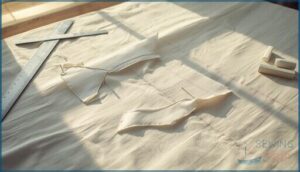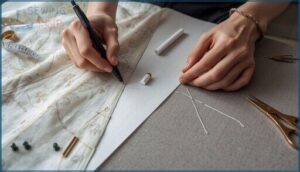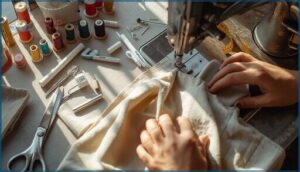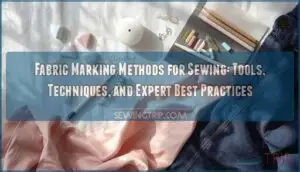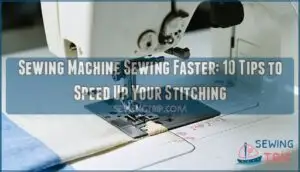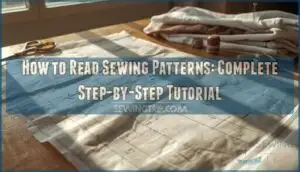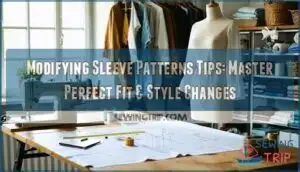This site is supported by our readers. We may earn a commission, at no cost to you, if you purchase through links.
Stand in front of a well-fitted jacket, and you’ll notice: every seam, every drape, every flash of color tells a story about the hands that made it. Great garment construction isn’t a trick of the light or luck at the machine—it’s the result of expert choices at each step, from fabric selection to the final press.
Whether you’re creating heirloom dresses, updating a wardrobe staple, or chasing that elusive perfect fit, understanding the small decisions behind professional tailoring makes all the difference. Improve your craft with expert sewing advice that transforms fabric and intention into pieces worth wearing again and again.
Table Of Contents
Key Takeaways
- Choosing the right fabric, paying attention to fiber content, weight, drape, and grain alignment, is the foundation for both comfort and a well-fitting garment.
- Precision in cutting, pattern placement, and marking ensures every piece lines up perfectly, preventing distortion and flaws as you sew.
- Mastering essential machine and hand sewing techniques, plus the selective use of interfacing, brings strength, detail, and structure to your creations.
- Quality control, from inspecting seams to polished finishes and proper pressing, is what elevates a handmade piece to professional standard.
Expert Fabric Selection for Garments
Choosing the right fabric is where great garment construction begins. Your decisions here shape not just how the piece looks, but also how it feels and lasts.
Let’s explore what matters most when picking fabric for any project.
Understanding Fiber Content and Care
Start every project with fiber content in mind—it’s the backbone of smart fabric selection and durable garment construction. Natural fibers like cotton or wool crave gentle handling, while synthetics need cold washes to guard against weakening. Embrace blends for the best of both worlds.
Consumers show a strong preference for clothing made of cotton. Textile science guides you—proper fiber care equals longer life and professional sewing results.
Assessing Fabric Weight and Drape
Once you know your fiber content, shift focus to fabric weight and drape—two pillars of smart fabric selection. GSM standards clarify how weight shapes garment flow and structure, while the drape coefficient and fabric stiffness predict silhouette and comfort.
Selecting the right material also requires understanding breathability properties to assure comfort. Fluid draping isn’t just showy technique; it’s where textile science transforms fabric manipulation into expressive, precise garment construction that really moves with you.
Color Matching Under Various Lighting
Ever stitched a garment, only to see the color shift under different lights? That’s metamerism at work—a true test of your fabric selection savvy.
High CRI lighting or a light booth exposes color mismatches, while surface texture can heighten hue shifts.
Use instrumental measures and sound sewing techniques to make sure your finished piece holds its own anywhere.
Aligning Fabric Grain for Structure
You might’ve picked the perfect shade, but fabric grain alignment is what keeps that beauty from warping with each wash. Grainline importance isn’t just theory—precision here boosts structural integrity and fit.
Ignoring it risks twisting seams and distortion. Use reliable alignment methods to prevent skewing and unwanted bias effects; it’s how great garment construction stands the test of time.
Evaluating Air Permeability for Comfort
Comfort perception isn’t a luxury—it’s the result of smart fabric selection grounded in textile science. Want breathability that truly handles moisture and heat? Choose materials with high air permeability ratings and trust industry testing standards.
For reliable comfort in garment construction, look for these:
- Fabric breathability scores above 40 L/m²/s
- Effective moisture management
- Proven thermal regulation
Precision Cutting and Marking Techniques
Let’s talk about the art of getting your fabric ready to sew. Precision in cutting and marking is what sets strong foundations for every garment.
Here’s how you can make certain every piece lines up just right.
Choosing The Right Cutting Tools
Choosing the right cutting tools makes or breaks your garment construction. Rotary cutter types offer fast, clean slices for layered fabrics, while scissor ergonomics guard your hand during long sessions.
Regular maintenance practices stretch blade lifespan, and sharp sewing tools boost both speed and safety.
Prioritize cutting tool safety—precision isn’t just about the right fabric selection, but the skill behind each cut.
Accurate Pattern Placement and Grain Alignment
Laying out your patterns with precise accuracy is where ideal garment construction begins. Aligning the grain line—never skimping on fabric preparation or pattern weights—guards against distortion during wear.
Stick to a tight tolerance error management of ±½ inch or less, since even the smallest misstep in pattern layout accuracy ripples into poor garment performance down the line.
Marking Methods for Professional Results
Ever struggled to see your markings mid-project? Here’s where industry know-how matters. Chalk vs. pens: chalk offers crisp lines, but pens excel on tight weaves.
Thread tracing stands out for complex pattern making, especially for garment fitting.
Use white carbon paper for subtle transfer and easy residue removal—no ghost marks to haunt your garment construction or sewing techniques. Precision always starts here.
Essential Sewing Techniques for Construction
No matter what you’re sewing, understanding the right techniques is what brings your garment together. These methods are the core skills that set a handmade piece apart from the rest.
Here’s what you need to know as you move from fabric to finished seams.
Mastering Machine Stitches and Seam Types
Think every seam tells a story? It does when you master machine stitches and seam types. Your sewing machine becomes your paintbrush—each stitch density and seam finishing method brings your garment to life.
Here’s what truly sets your construction apart:
- Enhanced seam strength for high-stress zones
- Nuanced stitch density for lasting wear
- Efficient industrial applications
- Failure analysis driving improvement
- Quality control supporting every success
Hand Sewing for Delicate Details
Tiny stitches, big impact—that’s the heart of hand sewing for garment construction. Nothing matches the precision control of invisible stitches on delicate hems or the subtle art of couture detailing. Whether you’re thread tracing for perfect alignment or easing tension in fine silks, hand sewing brings true tailoring finesse where machines can’t reach.
Hand sewing delivers unmatched precision and finesse, transforming tiny stitches into delicate, tailored details machines simply cannot achieve
| Technique | What It Delivers |
|---|---|
| Invisible stitches | Polished, refined finish |
| Thread tracing | Unequaled pattern accuracy |
Applying Interfacing for Stability
After perfecting those tiny hand stitches, let’s talk structure. Interfacing is the silent backbone of good garment construction. Choosing the right interfacing type and application method—matched to your fabric’s weight and drape—prevents puckering or stiff spots.
Pay close attention to quality control and shrinkage rates, since even small missteps can affect the finished fit and durability.
Pressing and Steaming for a Polished Finish
So, you’ve built stability with interfacing—now, let that garment shine. Pressing and steaming are where magic meets method in garment construction. Mastering ideal temperature and moisture control helps prevent puckering and shine. Reliable sewing techniques rely on:
- Proper equipment maintenance for consistent results
- Using pressing cloths for fabric protection
- Finishing techniques to avoid costly errors
Advanced Methods for Complex Garments
When you’re ready to push your sewing skills further, sophisticated techniques can open up a world of creative possibilities. These methods let you experiment, solve challenges, and make garments that truly stand out.
Let’s take a closer look at what you can try next.
Draping and Pattern Manipulation
Mastering draping and pattern manipulation breathes life into your designs, boosting silhouette versatility and garment construction precision. Using muslin fabric lets you perfect shapes affordably, while digital draping tools speed up pattern making and enable swift pattern fit adjustments.
You’ll notice draping efficiency knocks down waste, and proper couture draping brings those impossible-seeming ideas straight from form to fabric.
Embellishments: Embroidery, Appliqué, and Texture
Once you’ve shaped a beautiful form, embroidery techniques or appliqué methods add soul and story. Think luxury embroidery or lasercut embellishments—strategic choices here shift fabric texture and transform a design from basic to breathtaking.
Every stitch and layer impacts garment construction, wearer comfort, and even the economic effects behind fashion accessories and embellishments seen on global runways.
Leatherwork and Specialty Fabrics
Leatherwork heightens garment construction, testing your skill in Fabric Selection, Needle Selection, and chosen Sewing Techniques. For sewing leather, invest in specialty Sewing Machines and sharp tools; pair with thoughtful Seam Finishes to boost garment durability and style.
Specialty fabrics—like velvet or vinyl—demand equally precise care methods, so always adapt your method to suit material and design for polished Garment Making.
Integrating Modern Sewing Technologies
If you’re looking to bring your craft into the future, lean into Fashion Technology—think Machine Learning–guided Sewing Machines, Smart Textiles, and Digital Patterns driving Apparel Manufacturing.
Automation Benefits go beyond speed; they boost precision and minimize waste.
Modern Garment Construction now means your Sewing Techniques grow smarter, supporting Sustainability Impact and reshaping how you sew with purpose.
Quality Control and Finishing Touches
Now comes the moment when your garment really earns its polish. Quality control and finishing touches make the difference between “almost” and “expert.”
Here’s what you want to check before you call your project done.
Inspecting for Common Defects
Ever noticed how one tiny flaw in a seam reveals a string of hidden issues? That’s the butterfly effect at play in Garment Construction.
Defect Identification requires sharp eyes and a systematic touch—use clear Inspection Methods, follow AQL Standards, and always dig for Root Causes.
Quality Control isn’t just about catching errors but reducing costly rework across Apparel Construction.
Professional Seam Finishing Techniques
Curious why some clothes seem built for the long haul? It comes down to seam finishing mastery. Overlock Durability dominates mass-market garment construction, French Seams shine in luxury, Flat-Felled Strength is denim’s backbone, and Zigzag Alternatives keep home sewing accessible. Bias Binding adds polish, making these finishing techniques real improvements in sewing skills:
- Boost durability with flat-felled seams
- Use overlocks to fight fraying
- Apply French seams for sheers
Hemming, Edging, and Closures
Every sharp garment tells its story through Hemming, Edging, and Closures. Blind Hemming escapes notice, but not scrutiny—perfect for a crisp pant or skirt. Edge Bindings outsmart fraying, especially on activewear.
Master your Zipper Types and prioritize Button Security to avoid closure defects. Smart Garment Construction and Seam Finishing tie these sewing techniques together, raising your work above the rest.
Final Pressing and Pattern Alignment Checks
Precision in final pressing is where your garment’s life truly begins. Dial in your pressing temperature—too much heat, and you risk shining or warping fabric.
Rely on symmetry standards and alignment tolerances to check every seam. AI patterning and quality control raise your appearance metrics, ensuring your garment construction and finishing techniques deliver impeccable results, inside and out.
Frequently Asked Questions (FAQs)
How can I prevent fabric from puckering during sewing?
Think of fabric puckering like ripples in a calm pond—usually, it means your Needle size, Thread tension, Fabric preparation, Stitch density, or Thread quality isn’t quite right.
Mastering these basics will keep your Garment Construction smooth.
What are the best practices for sewing curved seams?
For perfect curved seams, focus on Seam Preparation—mark with chalk, use Clipping Techniques on curves, shorten stitch length, stitch slowly, then press.
This combination of Sewing Techniques and Shaping reduces defects, ensuring sturdy, professional Garment Construction.
How do I choose the right thread for stretch fabrics?
For stretch fabrics, stick with polyester or textured nylon thread fiber types—these offer seam durability, reliable recovery, and fit most sewing techniques.
Specialty stretch threads excel for activewear, as industry recommendations highlight their greater elasticity.
Use proper tension and needles.
What techniques help manage bulk at seam intersections?
When sewing turns into a game of cat’s cradle at seam crossings, seam grading, careful trimming methods, and precise notching curves are your ace in the hole.
Pressing techniques and layer reduction keep Seam Allowances flat, elevating your Garment Construction Techniques.
How can I achieve even topstitching on tricky fabrics?
Achieving even topstitching on tricky fabrics starts with precise needle selection and stabilizer usage. Adjust stitch length, use specialty presser feet, and prep fabric well.
These sewing techniques are key garment construction sewing tips in any sewing machine tutorial.
Conclusion
Sewing isn’t just patchwork—it’s powerful problem-solving in disguise. Every time you pause to match grain lines or listen to the fabric under your fingertips, you hone the invisible art behind truly beautiful garments.
That’s the heart of expert sewing advice for garment construction: attention to small details that give your creations lasting impact. Treat each stitch like a quiet conversation between intention and technique, and you’ll find your hands crafting the kind of work future generations admire.
- https://www.amefird.com/wp-content/uploads/2010/01/Seam-Engineering-2-5-10.pdf
- https://www.smartpatternmaking.com/blogs/articles/how-to-collect-sewing-performance-data-spd
- https://successfulfashiondesigner.com/garment-construction-defects/
- https://pmc.ncbi.nlm.nih.gov/articles/PMC9051004/
- https://www.uniformmarket.com/statistics/global-apparel-industry-statistics



